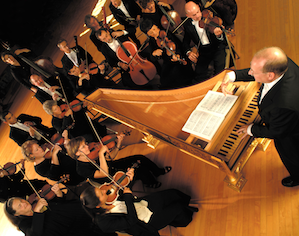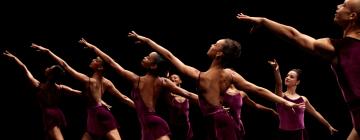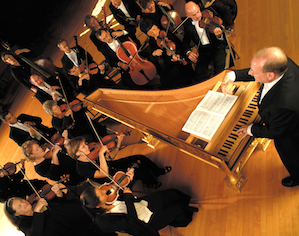
Photo by Paul Trapani
For its latest concert program, Philharmonia Baroque chose as its theme “The Italian Violin,” but it might as well have named it “Italian Musical Fireworks,” for that was what it produced on stage last weekend during concerts in San Francisco and Berkeley.
Leader Rachel Podger, joined by PBO Concertmasters Elizabeth Blumenstock, Katherine Kyme, and Carla Moore, played a spectacular series of Italian concertos for one, two, and four solo violins from such Italian Baroque composers as Corelli, Vivaldi, Mossi, Pergolesi, and Locatelli. (Yes, the “I’s” have it.) The last concert in this series takes place on Wednesday, March 20, in Bing Concert Hall at Stanford University.
The style period in musical history that is now commonly referred to as the Baroque (the term is a 20th-century invention) was a time of great change in Western art music. Building on elements from the Renaissance, composers started writing music that became increasingly more complex, elaborate, and ornate, intended for larger groups of musicians.
The concerto — an instrumental work that contrasts an orchestral ensemble with a smaller group or a solo instrument — was one of the major inventions of the Baroque, and one that became immensely popular. Vivaldi alone wrote more than 500 of them, so today the task of simply choosing suitable music and putting together a concert program can be an arduous one. Still, last weekend Philharmonia Baroque gave an excellent, largely chronological summary of the various ways in which composers approached the concerto form.
On Friday in San Francisco, the British Baroque specialist Rachel Podger played two solo concertos: Vivaldi’s Concerto for Violin in A Major, Op. 9, No. 6, RV 348, from La cetra (1727) and the Violin Concerto in B-flat Major that Giovanni Battista Pergolesi wrote as a young man (he died at age 26, in 1736).
Podger is a most “interactive” soloist. On stage, she doesn’t take herself too seriously and connects very directly and intimately both with the audience and with her fellow musicians — conducting them with, at times, whimsical facial and bodily expressions.
The concerto … was one of the major inventions of the Baroque.
Where Vivaldi (whose music somehow sounds eternally optimistic and, to me at least, bright “yellow”) was exploring the extremes of the Baroque violin, Podger followed with grace and ease, nimbly dancing across the strings and almost casually throwing around the composer’s many trills and adornments.
Pause for Humor
Pergolesi’s solo concerto is considerably darker than Vivaldi’s, in spite of the introduction to the third movement, which includes a number of comedic breaks and pauses. Podger’s interpretation of the second movement (Largo) was rich, deep, and full of longing, but the opening Allegro would have warranted another take, if this were a recording.
Elizabeth Blumenstock joined Podger in a different, equally sunny Vivaldi concerto: Op. 3, No. 5 from L’estro armonico, for two violins. The two dueling violinists chased each other around with such playful prowess and obvious, infectious pleasure that they received an extra curtain call.
The two dueling violinists chased each other around with playful prowess and obvious, infectious pleasure.
The fun was doubled again when Katherine Kyme and Carla Moore joined Podger and Blumenstock in concertos for four violins by Giovanni Mossi (1680–1742) and Pietro Locatelli (1695–1764). Virtually nothing is known of Mossi’s life, but, like Locatelli, he spent most of his working life in Rome.
As can be expected, both these composers applied a good deal of call-and-response and other kinds of “backing-and-forthing”-effects in their concertos, pitting the four solo violins against each other (or sometimes in pairs), having them finish each other’s sentences, responding, answering questions, and bouncing little musical motifs around.
Together, the four virtuoso violinists told one musical story, but each in their own voice, showing glimpses of their personalities and characters: one soloist perhaps a little freer than another, laying new emphasis or applying a slightly different timbre.
And after all this violinistic cheer, the audience was sent home with another delight, this time an appropriately meditative melody from Signore Vivaldi himself.

